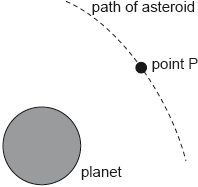| Date | November 2020 | Marks available | 2 | Reference code | 20N.2.HL.TZ0.8 |
| Level | Higher level | Paper | Paper 2 | Time zone | 0 - no time zone |
| Command term | Explain | Question number | 8 | Adapted from | N/A |
Question
The diagram shows the electric field lines of a positively charged conducting sphere of radius and charge .
Points A and B are located on the same field line.
A proton is placed at A and released from rest. The magnitude of the work done by the electric field in moving the proton from A to B is . Point A is at a distance of from the centre of the sphere. Point B is at a distance of from the centre of the sphere.
Explain why the electric potential decreases from A to B.
Draw, on the axes, the variation of electric potential with distance from the centre of the sphere.
Calculate the electric potential difference between points A and B.
Determine the charge of the sphere.
The concept of potential is also used in the context of gravitational fields. Suggest why scientists developed a common terminology to describe different types of fields.
Markscheme
ALTERNATIVE 1
work done on moving a positive test charge in any outward direction is negative ✓
potential difference is proportional to this work «so decreases from A to B» ✓
ALTERNATIVE 2
potential gradient is directed opposite to the field so inwards ✓
the gradient indicates the direction of increase of «hence increases towards the centre/decreases from A to B» ✓
ALTERNATIVE 3
so as increases decreases ✓
is positive as is positive ✓
ALTERNATIVE 4
the work done per unit charge in bringing a positive charge from infinity ✓
to point B is less than point A ✓
curve decreasing asymptotically for ✓
non zero constant between and ✓
✓
✓
✓
to highlight similarities between «different» fields ✓
Examiners report
The majority who answered in terms of potential gained one mark. Often the answers were in terms of work done rather than work done per unit charge or missed the fact that the potential is positive.
This was well answered.
Most didn't realise that the key to the answer is the definition of potential or potential difference and tried to answer using one of the formulae in the data booklet, but incorrectly.
Even though many were able to choose the appropriate formula from the data booklet they were often hampered in their use of the formula by incorrect techniques when using fractions.
This was generally well answered with only a small number of answers suggesting greater international cooperation.


